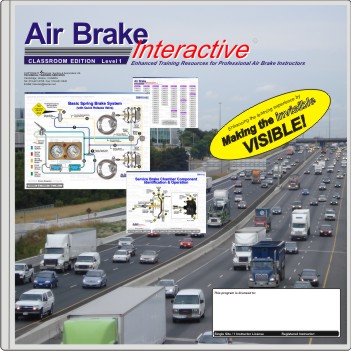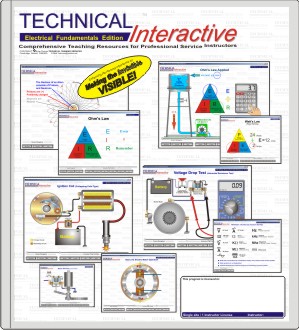
AIR BRAKE Interactive Classroom Edition (ABI-CE)
AIR BRAKE Interactive Classroom Edition (ABI-CE) is an air brake training and teaching resource designed for air brake service instructors teaching entry to intermediate-level air brake students and service technicians. It is also well suited for advanced air brake training for drivers. ABI-CE is a complete, presentation-ready, training package that has been carefully structured to deliver a progressive and effective learning experience.
The AIR BRAKE Interactive CE package comprises a highly detailed, full-color, 12-module, 350-page Instructor’s Reference and Presentation Guide supported by a state-of-the-art multimedia presentation.
What’s Included:
Sample Animations
The Instructor’s Reference and Presentation Guide
The Instructor’s Reference and Presentation Guide is an essential resource designed to empower presenters with comprehensive reference material and a clear, step-by-step roadmap for delivering their program effectively. This guide serves as a valuable tool, ensuring that instructors can confidently present their content with precision and consistency.
By combining with the program’s powerful multimedia support animations and visuals, you are assured of a thorough, accurate, and consistent presentation by every instructor, every time!
Available Student Workbook
Enhance your AIR BRAKE Interactive Classroom experience with our high-quality, full-color, 110-page Student Workbook. Designed to perfectly align with the structure and content of your classroom presentations, this workbook serves as an invaluable resource for students, both during and after their air brake studies. Call or e-mail us for details and pricing.
The Multimedia Presentation
The Multimedia Presentation is a powerful teaching tool that brings the operation of a modern heavy vehicle air brake system to life. With 44 voice-narrated technical and mechanical animations, paired with over 75 additional technical visuals, this presentation delivers a comprehensive and engaging learning experience.
Key highlights include:
Detailed Animations: Voice-narrated animations simplify complex concepts, making them accessible and memorable.
Enhanced Understanding: Combines audio, visuals, and animations for an immersive learning experience that ensures students grasp and retain the material effectively.
Extensive Visuals: Over 75 technical visuals provide in-depth insights into the air brake system’s operation.
This is a visual learning experience that your students will understand and remember.
Presenting the Program
You can present the entire ABI-CE program (approximately 16 classroom hours) or pick and choose what subject matter you wish to contribute and what individual visual elements you want to employ. It’s up to you.
AIR BRAKE Interactive IS NOT a re-assembly of age-old air brake training material that has been around for decades. AIR BRAKE Interactive CE employs ALL NEW and ORIGINAL MATERIAL. Its content, structure, system diagrams, technical animations, and illustrations have been carefully designed and created to reflect current air brake technology. AIR BRAKE Interactive CE will provide your students with the most thorough air brake education possible. It is the most comprehensive and effective air brake teaching resource available today.
For more information on each module, click on the “v”.
ABI-CE Content

For more information and to discuss your specific needs, ideas, or questions with one of our expert teaching resource developers, we encourage you to reach out to us. Our team is dedicated to creating high-quality, engaging, and effective teaching materials tailored to your unique requirements. Please don’t hesitate to contact us via:
Bryan Duross
TECHNICAL TRAINING SERVICES
Telephone: 519-621-0708
E-Mail: bduross@sentex.net
For a FREE full-version demo, Contact Us!

Classroom Edition
Available Formats
Traditional Install
Online Access

